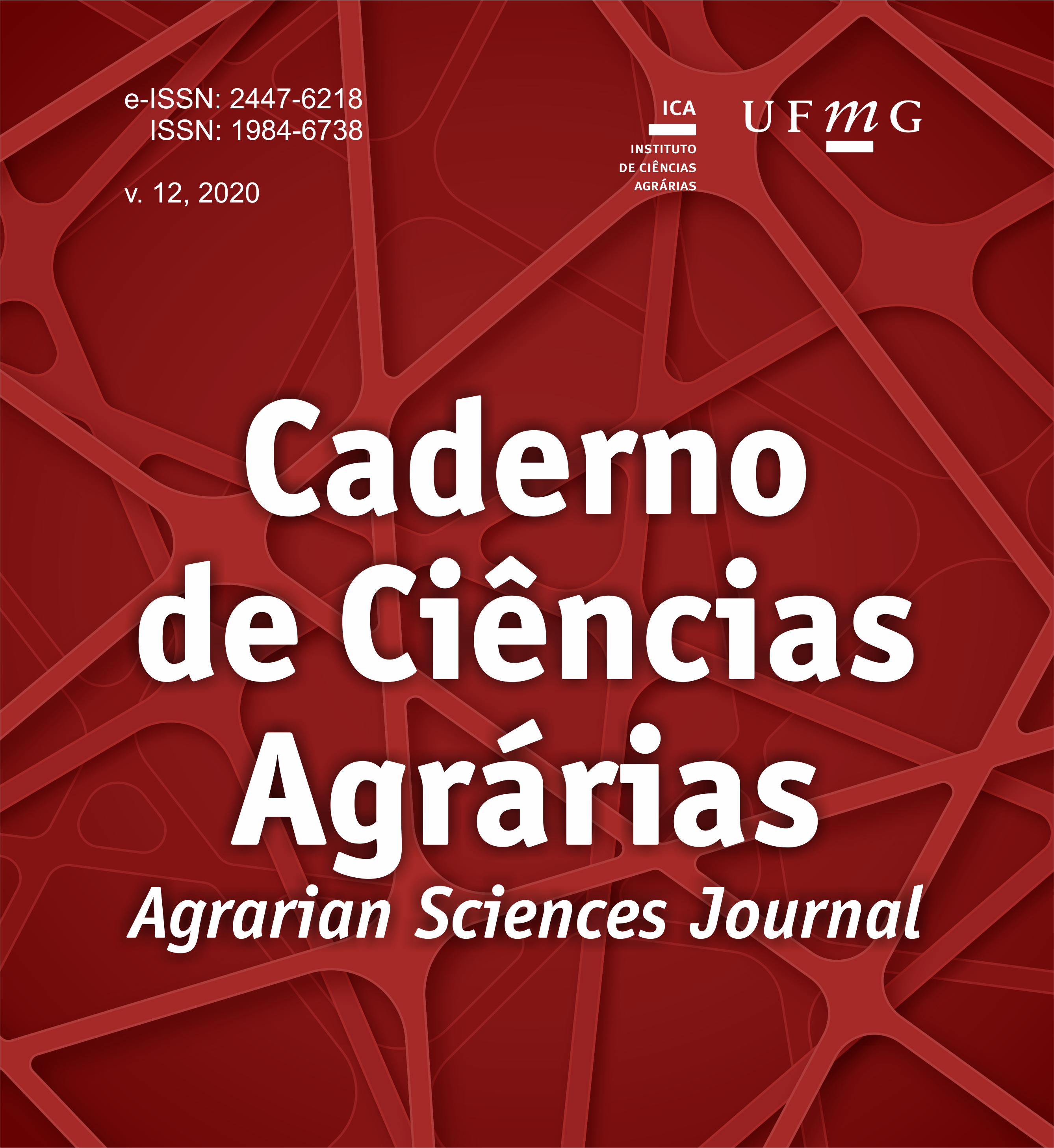In vitro establishment of Ceiba rubriflora Carv.-Sobr. e L. P. Queiroz
an endemic species of the São Francisco River Valley
DOI:
https://doi.org/10.35699/2447-6218.2020.24029Keywords:
Ruby paineira, Calcareous Dry Forest, Species conservation, MicropropagationAbstract
Ceiba rubriflora is a native Brazilian species, critically endangered, from region of middle São Francisco River. C. rubriflora's seed production is scarce because of its endemism. Therefore, the micropropagation is presented as a tool for its propagation and seedling production. Thus, the aim of the present study was to evaluate the in vitro establishment of C. rubriflora seeds after disinfestation with different concentrations of active chlorine and testing the in vitro multiplication of apical shoots in different concentrations of 6-benzylaminopurine (BAP). The in vitro establishment of seeds was performed in MS culture medium, which were previously submitted to sodium hypochlorite (NaOCl) disinfection at concentrations of 0.0; 0.5; 1.0; 1.5; and 2.5% active chlorine. Apical shoots of in vitro germinated seedlings were used as explants for multiplication, in MS culture medium, supplemented with BAP in concentrations of 0.0; 1.0 and 2.0 mg L-1. The evaluations were related to seedling survival, fungal and bacterial contamination and number of shoots per explant. The in vitro germination of seeds was satisfactory, with survival rate higher than 98%. The percentage of in vitro contamination was only 2%, free from bacterial cultures. The apical shoots of C. rubriflora were not multiplied in a single subculture in vitro in BAP culture medium. The results demonstrate the viability of in vitro germination of C. rubriflora seeds for the introduction and subsequent micropropagation process, opening perspectives for further studies with the species.
Downloads
References
Al-Khateeb, W., Bahar, E., Lahham, J.; Schroeder, D. 2013. Regeneration and assessment of genetic fidelity of the endangered tree Moringa peregrina (Forsk.) Fiori using Inter Simple Sequence Repeat (ISSR). Physiol Mol Biol Plants, 19: 157–164. doi: https://doi.org/10.1007/s12298-012-0149-z.
Almeida, L. M. S.; Morais, L. E.; Resende, C. F.; Braga, V. F.; Pereira, P. F.; Silva, R. A. C; Peixoto, P. H. P. 2015. Micropropagation and acclimatization of Aegiphila Verticillata Vell.: an endangered woody species. Revista Árvore, 39: 305-314. doi: https://dx.doi.org/10.1590/0100-67622015000200010.
Aragão, V. P. M.; Navarro, B. V.; da Silva, A. T.; Silveira, V.; Santa-Catarina, C. 2018. Micropropagation of Cariniana legalis (Martius) O. Kuntze, an endangered hardwood tree from the Brazilian Atlantic Forest. Plant Cell Culture & Micropropagation, 13: 41-50. Disponível em: http://pccm.ufla.br/index.php/plantcellculturemicropropagation/article/view/116/60
Brondani, G. E.; Oliveira, L. S. D.; Bergonci, T.; Brondani, A. E.; França, F. A. M.; Silva, A. L. L. D.; Gonçalves, A. N. 2013. Chemical sterilization of culture medium: a low cost alternative to in vitro establishment of plants. Scientia Forestalis, 41: 257-264. Disponível em: https://www.ipef.br/publicacoes/scientia/nr98/cap11.pdf
Carvalho-Sobrinho, J. G.; Queiroz, L. P. 2008. Ceiba rubriflora (Malvaceae: Bombacoideae), a new species from Bahia, Brazil. Kew Bulletin, 63: 649-653. doi: http://dx.doi.org/10.1007%2Fs12225-008-9070-6.
Ceiba in Flora do Brasil 2020 em construção. Jardim Botânico do Rio de Janeiro. 2019. Disponível em: http://reflora.jbrj.gov.br/reflora/floradobrasil/FB115104.
George, E. F.; Hall, M. A.; De Klerk, G. J. (Ed.). 2008. Plant propagation by tissue culture: volume 1. Springer Netherlands.
Lazarotto, M.; Muniz, M. F. B.; Santos, A. F. 2010. Detection, transmission, pathogenicity and chemical treatment of fungi in Ceiba speciosa seeds. Summa Phytopathologica, 36:134-139. doi: https://doi.org/10.1590/S0100-54052010000200005.
Lazarotto, M.; Piveta, G.; Muniz, M. F. B.; Reiniger, L. R. S. 2011. Adequação do teste de tetrazólio para avaliação da qualidade de sementes de Ceiba speciosa. Semina: Ciências Agrárias, 32, 1243-1250. doi: https://doi.org/10.5433/1679-0359.2011v32n4p1243
Mahr, D. L. 2009. Some Succulent Trees of Bahia and Minas Gerais, Brazil. Cactus and Succulent Journal, 81: 138-146. doi: https://doi.org/10.2985/015.081.0308.
MMA - Ministério do Meio Ambiente. 2019. Caatinga. Disponível em: https://www.mma.gov.br/biomas/caatinga.
Murashige, T.; Skoog, F. 1962. A revised medium for rapid growth and bio assays with tobacco tissue cultures. Physiologia Plantarum, 15, 473-497. doi: https://doi.org/10.1111/j.1399-3054.1962.tb08052.x
Oliveira, L. S.; Brondani, G. E.; Batagin-Piotto, K. D.; Calsavara, R.; Gonçalves, A. N.; Almeida, M. D. 2015. Micropropagation of Eucalyptus cloeziana mature trees. Australian Forestry, vol. 78, 219-231. doi: https://doi.org/10.1080/00049158.2015.1073211.
Pasqual, M.; Dutra, L. F.; Araujo, A. G.; Pereira, A. R. 2010. Prevenção de Contaminações microbianas na cultura de células, tecidos e órgãos de plantas. 61-161. In: Scherwinski-Pereira, J.E. (Ed.). Contaminações microbianas na cultura de células, tecidos e órgãos de plantas. Embrapa Informação Tecnológica, Brasília, DF, Brasil: Embrapa Informação Tecnológica.
REFLORA - Flora do Brasil 2019 em construção. Jardim Botânico do Rio de Janeiro. Disponível em: http://floradobrasil.jbrj.gov.br/
Silva, P. P.; Contim, L. A. S.; Freitas, D. V.; Aride, P. H. R.; Santos, A. L. W. 2010. Estabelecimento in vitro de ápices caulinares de sumaúma (Ceiba pentandra L. Gaertn). Scientia Agraria, 11: 437-443. doi: http://dx.doi.org/10.5380/rsa.v11i6.20389.
Stephin, S., Gangaprasad, A., Mathew, S.P. 2019. Enhanced in vitro shoot multiplication of Piper sarmentosum by suppression of apical dominance. Proceedings of the National Academy of Sciences, India Section B: Biological Sciences, 89: 1-8. doi: https://doi.org/10.1007/s40011-019-01086-w.
Takahashi, E. K. Transferência do gene atacina A para plantas de maracujá amarelo (Passiflora edulis Sims f. flavicarpa Deg.) por biobalística. 2002. Tese Doutorado. Piracicaba: Universidade de São Paulo, 137f. Disponível em: http://www.teses.usp.br/teses/disponiveis/11/11137/tde-03122002-083637/.
Wu, K., Zeng, S., Lin, D., da Silva, J. A. T., Bu, Z., Zhang, J., & Duan, J. 2014. In vitro propagation and reintroduction of the endangered Renanthera imschootiana Rolfe. Plos One, 9: e110033. doi: https://doi.org/10.1371/journal.pone.0110033
Published
How to Cite
Issue
Section
License
Copyright (c) 2020 Agrarian Sciences Journal

This work is licensed under a Creative Commons Attribution 4.0 International License.
Authors who publish in this journal agree to the following terms:
The Copyright for articles published in this journal follow authorship. The articles are open access, with their own attributions, in educational and non-commercial applications.
The journal reserves the right to make regulatory, orthographic and grammatical changes in the originals, with the aim of maintaining the standard language and the credibility of the vehicle. It will respect, however, the writing style of the authors.
Changes, corrections or suggestions of conceptual order will be forwarded to the authors, when necessary. In such cases, the articles, once appropriate, should be submitted for further consideration.
The opinions issued by the authors of the articles are their sole responsibility.







